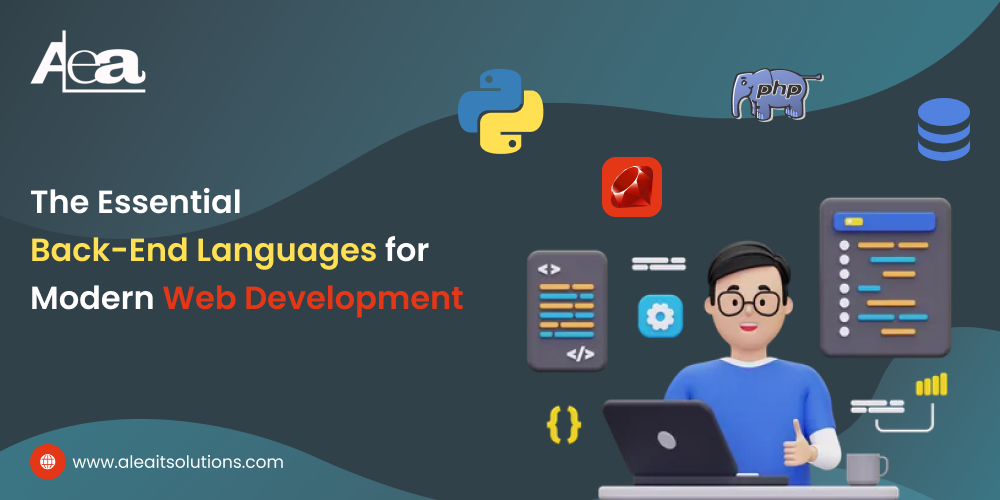In the sometimes developed landscape of technology, web development stands as an important component for businesses looking for online flourishing. From e-commerce platforms to social media networks, efficient, scalable and strong web apps have never been required. While the front-end-part users see and interact with-often occur in the spotlight, the back end is equally important. It is the backbone that supports the entire application, ensures data processing, server management and functionality. In this blog, we will find out the necessary back-end languages, which should consider every modern web developer, give details of matters of our strength and ideal use.
Understanding Back-End Development
Before diving in specific languages, it is necessary to understand what the back-end development is. Back-end development refers to everything occurring on the server side of an application. This involves managing database, server logic, application programming interface (API) and ensuring that the front-end and back-end are originally communicated. While the front-end developers focus on user experience and interface design, back-end developers handle heavy lifting that create application functions.
The selection of the right back-end language can significantly affect the performance, scalability and maintenance of an application. Various languages come up with their unique benefits and community support, which can shape the success of a project.
The Importance of Selecting the Right Language
The back-end language you have chosen should align with the goals of your project, the expertise of your team and the specific requirements of the application. Here are some factors to consider while choosing back-and language:
Performance: How well does the language handle concurrent requests?
Scalability: Can the language support your application because it grows?
Community and Support: Is there a strong community or documentation available?
Easy to learn: How much is the learning state standing for your team?
Integration: Does the language easily integrate with other devices and platforms?
Essential Back-End Languages
Let’s explore some of the most prominent back-end languages used in modern web development.
- JavaScript (Node.js)
JavaScript node.js. With the beginning of the front-end scripting language has crossed its role. This allows powerful runtime developers to use JavaScript for server-side programming, which enables complete-stack development with single language.
Key Features:
Non-Blocking, I/O: Node.JS uses an event-powered architecture, which makes it efficient to handle several connections simultaneously. It is particularly beneficial for real -time applications such as chat platforms and online gaming.
Vibrant Ecosystem: Node package manager (NPM) hosts a huge library of package and module, which can be easily integrated into projects, which increases the time of growth.
Community support: With a large and active community, developers can find a lot of resources, tutorials and library to increase their applications.
Use cases: node.JS is ideal for applications that require real -time capabilities, such as cooperation equipment, streaming services and interactive websites.
- Python
Python has gained immense popularity in various fields including web development. Its clear syntax and readability makes it an excellent choice for developers of all skill levels. Framework web applications like Django and Flask quickly provide strong equipment for the creation of web applications.
Key Features:
Versatility: Beyond web development, Python is used widely in data science, machine learning and automation, making it a valuable skill for developers.
Rich Framework: Django, known for the “batteries-included” approach, provides a comprehensive set of features just out of the box, while the flask offers flexibility for small projects.
Strong community: The Python community is one of the largest, providing adequate resources, libraries and platforms for support.
Use cases: Python is well suited for data-operated applications, material management systems and rapid prototypes due to ease of data-operated applications, material management systems and databases.
- Ruby
Ruby, especially with Ruby on Rails framework, has created a name for itself in web development. Ruby emphasizes convention on configuration, which allows developers to focus on writing clean, maintainable codes.
Key Features:
Rapid Development: Rails are designed to facilitate quick growth cycles, which makes it a favorite for start-ups and projects with a tight deadline.
Readable Syntax: Ruby’s syntax is spontaneous and expressive, which can reduce new developers on-board time.
Strong community: Ruby community is known for welcoming and helping, which has many resources available for learning and troubleshooting.
Use cases: Ruby on Rails is perfect for the creation of web applications that require rapid development, such as MVP (minimum viable products) and social networking sites.
- PHP
PHP has been a mainstay in web development since decades, mainly known to power management systems such as WordPress. Despite facing criticism over the years, PHP has developed significantly, modern outline revives its reputation.
Key Features:
Ease of use: PHP is relatively easy to learn and has a soft learning state, making it accessible to beginners.
Framework: Laravel database provides elegant syntax and powerful characteristics such as elegant ORM for management, making PHP growth more efficient.
Wide Adoption: A significant percentage of websites is created on PHP, which ensures the treasure of resources and community support.
Use cases: PHP is ideal for server-side scripting, dynamic website and material management systems.
- Java
Java is a long-standing player in the world of programming, especially in enterprise-level applications. Its platform freedom (thanks to the Java virtual machine) and strong performances make it a favorite among large outfits.
Key Features:
Object-oriented: Java’s object-oriented nature encourages clean code practices and re-uses.
Enterprise Framework: Framework such as spring and hibernate simplifies the development of complex applications, providing devices for injections, safety and database management.
Performance: Java applications can be highly performing, making it suitable for a large scale system.
Use cases: Java is usually used in large enterprise applications, banking systems and web services.
- C#
C# is a versatile language developed by Microsoft, which is widely used for the creation of Windows app and game. It also has strong abilities for back-end web development, especially within .NET framework.
Key Features:
Integration with Microsoft: C# is basically integrated with other Microsoft technologies, making it a great option for organizations using Microsoft stacks.
Strong framework: ASP.NET provides a powerful structure for the creation of web applications, MVC (model-controller) offers features such as architecture and underlying security.
Constructed language: C# is a strongly typed language, which can help capture errors on time.
Use cases: C# Microsoft is ideal for enterprise-level applications, sports development and applications within the ecosystem.
- Go (Golang)
Go, or Golang, is a language developed by Google that is receiving traction for its simplicity and efficiency. It excels in concurrent programming, making it a strong choice for cloud apps and micro services.
Key Features:
Consent: Go’s Go routine and channels make it easy to handle several tasks simultaneously, which is necessary for scalable applications.
Static typing: GO’s static typing can lead to a more estimated code, reducing the possibility of runtime errors.
Simplicity: The language is designed to make it simple and easy to read, allowing developers to create and maintain codes efficiently.
Use cases: GO is well suited for micro services, cloud applications and system programming.
Emerging Trends in Back-End Development
As technology moves forward, new languages and outline emerge. It is important for developers to remain relevant to keep these trends in mind.
Rust: Known for its memory safety and performance, the rust is gaining popularity for system-level programming and performance-mating applications.
Kotlin: Mainly associated with Android Development, interoperability with Kotlin’s Java also makes it a great option for back-end development.
Staying updated with these trends can help developers to make informed decisions to learn and use in their projects.
Conclusion
Choosing the right back-end language is an important decision that can greatly affect the success of your project. Each language discussed provides unique benefits and is favorable for various types of applications. Whether you are an experienced developer or simply starting, understanding these essential back-end languages will empower you to make an alternative to your projects.
At AleaIT Solutions, we are committed to leveraging the best technologies to bring your vision to life. If you’re ready to enhance your web development experience, reach out to us today!




